Portal-ness. Towards a cosmology of rift
Imagine another world
It was an inventive twist of the dubious notion of the “chance” or “opportunity” that the coronavirus crisis purportedly presents, when Arundathi Roy coined the alternate phrase “the pandemic is a portal”. It became the title of an essay that Roy published in the Financial Times in early April, to be included in her upcoming collection Azadi. Freedom, Fascism, Fiction (Hamilton/Penguin). “Azadi” is Urdu for “freedom” and has been the slogan of the struggle against what Kashmiris see as the Indian Occupation; in India it conversely and somewhat ironically became the chant of protest against the project of Hindu Nationalism.
Historically, calling for “freedom” certainly is one of the best rehearsed strategies for exiting a political situation perceived as being unbearable. Roy’s invocation of the architectural trope of the portal seems to befit the demand of “azadi,” for it indicates a way out of the world constituted to fail the basic condition of freedom for the disempowered masses.
The formulation of the FT essay’s title does not feature in the text itself, however, this is the passage in which Roy deploys the term “portal:” “Historically, pandemics have forced humans to break with the past and imagine their world anew. This one is no different. It is a portal, a gateway between one world and the next. We can choose to walk through it, dragging the carcasses of our prejudice and hatred, our avarice, our data banks and dead ideas, our dead rivers and smoky skies behind us. Or we can walk through lightly, with little luggage, ready to imagine another world. And ready to fight for it.”
With her use of the metaphor, expertly forging the alliteration “portal/pandemic,” Roy proposes an architectural vision of evasion, a topology of transcending the disaster of racial capitalism and Hindu nationalism in an act of refusal and an instantiation of a radically different future through struggle. Deliberately spatializing the effects of the pandemic — and spatial they are! —, the trope of the portal supplements Roy’s comparison of the lockdown in India to “a chemical experiment that suddenly illuminated hidden things:” Adding an urban sociologist’s perspective to the laboratory metaphor, she continues: “As shops, restaurants, factories and the construction industry shut down, as the wealthy and the middle classes enclosed themselves in gated colonies, our towns and megacities began to extrude their working-class citizens — their migrant workers — like so much unwanted accrual.”
The enclosures of the neoliberal-fascist present have become the biopolitical precondition of the extrusion of millions of workers, not only in India. Being able to withdraw from the city and from public sight bears an insidious entitlement. By escaping to enclaves of privilege the wealthy and powerful place themselves at a distance — spatially, psychologically, and socially — from those whose labor force they otherwise desire and exploit. The pandemic here supposedly works in favor of the ongoing systemic oblivion, or rather social sadism towards the individual lives of those who find themselves first disempowered and then abandoned by racial capitalism.
Two questions could be derived from Roy’s architectural metaphor. Tentatively, they may be put as follows: If the pandemic is a portal, how could it serve the needs and causes of those whose portals are not the private jet, SUV, inheritance, education, superior healthcare or other vehicles into the securitized territories of privilege? If the pandemic is a portal, how can it be envisaged and, even more, designed and constructed — according to, or redressing existing models of portal-ness?
To arrive at an, at least, provisional answer to these questions, it is necessary to recapitulate some of the semantic and cultural contexts where the concept of portal is implemented.
Mucosal epithelium
For one, there is the topical context of virology. Here, a conceptual distinction is being made between portals of entry and portals of exit. In both cases the agent of movement is the virus itself, as it enters or leaves the body of its host through the respective portals. A standard reference book, the 1976 Viral Infections of Humans. Epidemiology and Control (ed. by Alfred S. Evans), explains: “After entry through an appropriate portal, the virus must escape from ciliary activities, macrophages, and other primary defense mechanisms during its sojourn to the target cell, find appropriate receptors on the cell surface for its attachment, and be able to penetrate and multiply within the cell. […] Once released, viruses find their way to new hosts via one or more portals such as the respiratory tract (influenza, etc.), skin (varicella, smallpox), blood (hepatitis viruses via blood transfusion, arboviruses via mosquitos), gastrointestinal tract (enteroviruses), genital tract (herpes simplex type 2), urine (cytomegalovirus), and placenta (rubella, cytomegalovirus).” (pp. 5-6)
The language of this microbiological account borrows heavily from those of the travelogue and the adventure novel, in particular the literary genres featuring dramatic heists or prison escapes. The portals of entry and exit however deserve to be described in more detail, like, for instance, in Jennifer Louten’s Essential Virology (2016): “There are several different portals of entry that are used by different viruses. Most viruses interact with the cells of the host epithelium, the layers of cells that line the outside surface and inner cavities of the body. The epithelium acts as the main barrier between the outside world and the internal environment of the body. Mucosal epithelium, so named because the epithelium is covered in a protective layer of mucus, lines all the internal surfaces of the body, including the respiratory tract, gastrointestinal tract, and genital tract. The epithelium can be bypassed, however, when viruses are delivered to internal sites through penetration of the skin, as happens with an insect or animal bite, or through transplantation of a virally infected organ.”

“The mucosal epithelium presents a formidable structural and chemical barrier to ill-intentioned microbes, which gain entry into the lamina propria” (source: P.D. Smith et al., “Intestinal macrophages and response to microbial encroachment,” Mucosal Immunology, 4, 2011)
It becomes clear that most viruses have to pass through the mucosal epithelium that is both a gateway and “the main barrier between the outside world and the internal environment of the body.” With SARS-CoV-2, the huge surfaces of the respiratory tract in particular have proven once again to be the “most common” (Louten) portal of entry for viruses into the human body.
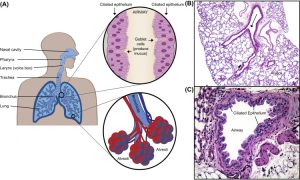
Respiratory Tract (from Jennifer Louten, Essential Virology, 2016)
“It is a system of tubes that allows for gas exchange between the body and the external environment. The mucosal surfaces of the respiratory tract translate to a very large surface area with which viruses can interact. A resting human inhales around 2 gallons of air every minute, and within each breath are aerosolized droplets and particles that could contain viruses, such as from a cough or sneeze of an infected individual.” (Louten 2016)
The architecture of the mucosal portal, its design, morphology, and spread, is a result of all sorts of evolutionary and biological processes, of productivity entailed by the necessities of adaptation and survival, of defense and vitalism. The existing imagery of these surfaces’ construction is of course to be taken for what it is: as the sum total of attempts at the visualization in the service of the human eye and science communication. This said, the mucosal surfaces, as made known via visual representations and medical text, could also inform the construction of future portals of the kind envisaged by Arundhati Roy.
Portal Fiction
A more likely (and popular) resource however are the numerous portals and gates invented by science fiction and fantasy in literature, film, and games. Drawing on various SF encyclopaedias, Wiki articles on the portal in SF (German, English) abound with references to space travel, teleportation, parallel worlds, multiverses, time travel. From standards of portal fiction such as Lewis Carroll’s 1871 Alice Through The Looking Glass to more recent examples such as the TV series Stranger Things, they cite

the space-time phone box TARDIS (Time And Relative Dimensions In Space) from the TV series Doctor Who,

the wardrobe in the C.S. Lewis-inspired Disney franchise Chronicles of Narnia,
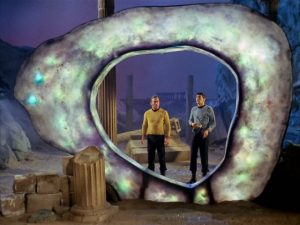
the portal of the Guardians of Forever from the Star Trek episode “The City on the Edge of Forever” (written by Harlan Ellison),
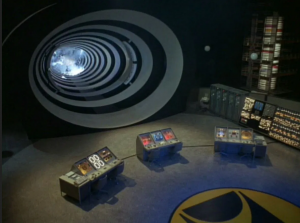
the “time tunnel” of the eponymous TV series,
or the so called “anomalies” in another TV series, Primeval.
More prominent portals feature in Stargate (the movie and the TV series) or the TV series Babylon 5 (with their “jumpgates” for space ships).
Portal to go
The architectural fantasies of portals modelled after furniture (wardrobes, doors) or public art (temples, churches) have their limits, and attempts have been made to expand the scope of portal design and uses.
In the computer games Portal (2007) and Portal 2 (2011), developed by Valve, a leading game developing and publishing company, players solve puzzles by placing portals and teleporting devices between them. Both games can be played by a single player as well as in a cooperative mode. The placing of the portals is carried out by using the “Aperture Science Handheld Portal Device,” a gun-like device to create inter-spatial portals between two flat planes. As the relevant Wikpedia article explains: “The player-character, Chell, is challenged and taunted by an artificial intelligence named GLaDOS (Genetic Lifeform and Disk Operating System) to complete each puzzle in the Aperture Science Enrichment Center using the portal gun with the promise of receiving cake when all the puzzles are completed. The game’s unique physics allows kinetic energy to be retained through portals, requiring creative use of portals to maneuver through the test chambers.”
Portal 2 offered additional features including tractor beams, lasers, light bridges, and paint-like gels that alter player movement or allow portals to be placed on any surface.
Portal and Portal 2 have engendered numerous fan marketing products, such as short videos about a woman that wakes up in a room with no memory of who she is or how she got there which makes her use her hand-held portal-carving machine;
or about a woman dreaming of cherry cake and scratching her own back after having prepared the scene with her portable portal gun.
Portal: Survive! is another live-action short film based on the game Portal, and the tie-in comic Portal 2: Lab Rat, directed by Colin and Connor McGuire, and shot in 2013 for under $500 at the YouTube Space LA.
and Aperture Flashbacks has been directed by Jillian Helt as a “fan made film made under the fair use copyright law for educational purposes: this film was produced in order to fulfil the CAS requirements of the International Baccalaureate Program.”
In addition to the fan movies, an “unauthorized” parody musical mocking the histrionics of Portal 2 was brought to the stage by Geekenders in Vancouver in 2015, featuring a complete album of songs published alongside on Bandcamp.
Going beyond
In his 2004 Historical Dictionary of Science Fiction Literature, Brian Michael Stableford introduced the notion of a “portal fantasy” genre, where portals have become constitutive of “sf multiverses and galactic empires.” Portals are required to sustain such cosmologies, allowing “for convenient transportation across their vast stages.” However, Stableford muses, “such portals pose problems of plausibility in sf stories dealing with parallel worlds and time travel.” One way of solving these problems, pace Stableford, is “re-jargonization,” i.e. the language of “dimensional doorways,” “stargates” or “timegates” itself. The other, arguably more interesting and generative strategy “is to transform the object of transportation — whether it be a person or a vehicle — so that it hauls itself across the dimensional boundary […].” (p. 270)
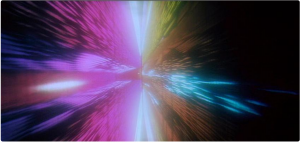
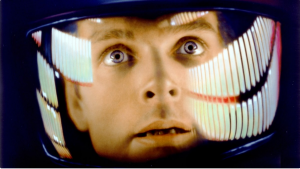
One of the most exciting and genre-bending portals of SF and movie history is introduced in the third act of Stanley Kubrick’s 2001: A Space Odyssey: the famous trippy star gate sequence of astronaut David Bowman’s escape from human history and AI (HAL) hegemony. It dynamized and decentered any notion of a portal’s stable architecture that viewers may have been holding onto at the time of the movie’s release in 1968.
The spectacular kaleidoscopic fluidity of this rendition of a passage through space-time was the result of heavy special effects tinkering, involving, among other tools and materials, toothpicks and banana oil. In a reconstruction of the sequence’s production, Michael Benson wrote in his 2018 Space Odyssey: Stanley Kubrick, Arthur C. Clarke, and the Making of a Masterpiece: “Powerful lights permitted high camera speeds, crucial in capturing the high-speed alchemy of surface tension, color change, and chemical reaction that they were after. The overcranked camera shooting at seventy-two frames per second produced a smoothly nuanced ‘galactic’ slow motion as they used toothpicks to drip blobs of white paint into the ink-thinner mixture. Reacting to the banana oil, the paint sent ersatz star flows and galactic tendrils streaming into cosmic space. A macro lens made an area the size of a playing card look like a nebula light years across. […] Christiane Kubrick remembers the brassiere factory scene vividly. Big, low tables supported shallow square-sided metal tanks and cans of paints and chemicals. A stink of thinner, ink, and lacquer ‘rotting’ under the hot film lights filled the air. The materials Stanley was working with fostered bacteria growth and became ‘unspeakably disgusting.’ Life arose in Kubrick’s ephemeral micro-universe, replicating exponentially within the expanding star clusters and morphing nebulae even as they were captured on film at high frame rates.” (pp. 81-82)
This comes as close to a description of the material construction of a portal as possible, and despite being an account of the fabrication of a fiction, it bears the power to inform every conceptualization and design strategy pursuing a portal that actually works as the sought-after tropological-topological device to pass a rift into a utopian territory of post-capitalism and social justice.
In terms of literally building portals, block by block, the computer game Minecraft (created by Markus Persson and Jens Bergensten) probably provides a comparably accessible training ground. Here portals are constructed by the players making 3D-frames of obsidian blocks with a rectangle in the centre to reach an alternate hell-like dimension called “The Nether.”
However, as intriguing as these architectures may appear (particularly to those who toiled on them for hours), the craft they represent and require clearly doesn’t suffice to radically innovate the way in which portals are to be imagined (and built) in an ongoing global crisis of which Covid-19 might prove to have been only a parable.

A particularly beautiful notion of the portal is put forward by the Black Quantum Futurism Collective, an interdisciplinary art practice between the Philadelphia-based musician, poet and activist Camae Ayewa (also known under her stage name Moor Mother) and the artist, author, community activist and lawyer Rasheedah Phillips. BQF “weaves quantum physics, Afrofuturism, and Afrodiasporic concepts of time, ritual, text, and sound to present innovative works and tools offering practical ways to escape temporal loops, oppression vortexes and the digital matrix,” and has created the Black Womxn Temporal Portal. This portal “activates the plural, subjective, and quantum nature of the future(s) where Black woman, femmes, girls, and nonbinary folks exist and are safe, loved, and valued.” The portal, in its online incarnation as a web-based platform, “contains an open access, interactive nonlinear timescape/tapestry/temporal map/toolkit of Black womanist temporal rituals and tech preparing us for Black quantum womanist future(s).” Arguably, the future of portal-ness is forged in the present of queer-feminist afrofuturism. Considering political escapism in terms of a chronopolitics of tools and strategies that cherish and foster the experiences and histories of nonlinearity and diaspora critically expands the archives of portal-knowledge.
If the tendency to render the Covid-19 pandemic in terms of parable and metaphor is to accrue any beneficial substance, it would need an imaginary that doesn’t stick to a particular set of standardized notions of portal-ness, regardless of how properly futuristic their architectonics may seem. Arundhati Roy’s use of the trope gestures at the necessity to radically re-imagine the crisis (and its political, epidemiological, cultural, economic management). Rather than sticking to a critique of those (persons, groups, structures) indicted as responsible for the unfolding disaster, her turn to the portal metaphor invites an activity of world-building that takes place in flight, or rather in fugitivity. Burdened with a doubtful reputation, the practice and attitude of escapism may eventually prove to hold an adequate response to the dire realities of the present and the time to come. Breaking with neoliberal temporalities and racial spatialities, the virological knowledge of the mucosal interfaces of entry and exit, together with the knowledges stored in the archives of portal fiction produced by science fiction and fantasy aesthetics should be enlisted to bring about the kind of thinking that might lead to the light-weight travel and fight for an entirely different world, invoked by Roy. For this to happen, the painful “disruptions” of digital capitalism have to be replaced by the joyous cosmologies of rift, and the histories and futures of portal science and fantasy will be instrumental in yielding this shift. T.H.
June 27th, 2020 — Rosa Mercedes / 02